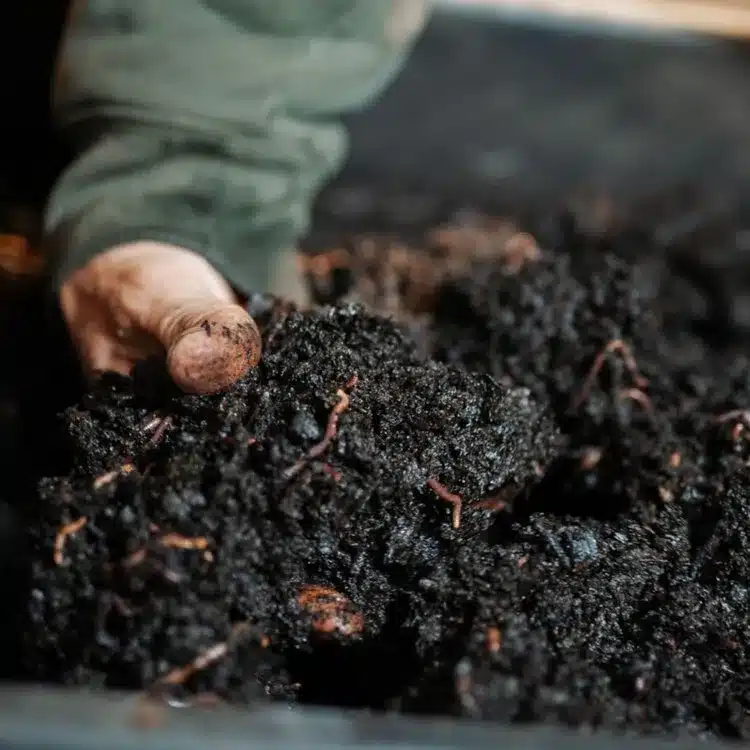Vermicomposting for Healthier Soil in the Gallatin Valley

“Worms stitch everything together.”
Karl Johnson, the founder and owner of YES Compost, gently pulls his fingers through the top layer of a compost bin at his Belgrade facility, inspecting the vibrant worm activity just beneath the surface.
“They make burrows and mucus, which creates a structural rigidity that prevents the compost from falling through the wire bottom of the bin. I think there are some adult worms over here.”
In his palm he holds a mound of bright Red Wiggler worms –all of them a small fraction of the size of an earthworm–just a handful of the 30,000 worms that live in Karl’s facility. You wouldn’t be able to tell based on the stillness of the compost surface, but these worms are in a state of constant activity, processing compost into the nutrient-rich byproduct of worm castings, or worm manure.
These humble worms are the keystone of YES Compost’s operations, transforming food waste in the Gallatin Valley and Big Sky into organic fertilizer for local gardens.
In its current iteration, YES Compost uses the “continuous flow” method, wherein the worms are fed a layer of fresh compost from above, and their castings are harvested from the bottom compost layers using a “breaker” bar, which cuts away the nutritious byproduct that naturally flows to the bottom of the bin. The worms remain undisturbed when their castings are harvested, and they thrive in the six to eight inches just beneath the compost surface. (Recently, the worms are enjoying local brewery food waste.)
Karl’s excitement about the worms is palpable. He demonstrates how to lay your hand palm-down in the bin, and the worms respond with a gentle ripple. The compost looks almost like a pool of water, with life swirling inside. And indeed, compared to the nutrient-sapped soil of modern industrial agriculture, the compost bins are absolutely rich with micro and macrobiotic life.
—

Karl Johnson founded YES Compost in 2018 after experiencing first-hand the huge gap in municipal composting services in Bozeman.
“The landfill is so cheap it’s hard to incentivize people to not just throw away their food. The trash service doesn’t cost as much as a compost service. For us, we have a cost for the whole process rather than just a hole in the ground.”
But harnessing food waste from the Gallatin Valley and Big Sky, while currently the main source of revenue for YES Compost, is not the only end goal. Karl sells the fertile worm casting compost as a local alternative to fertilizers, and hopes to expand this side of his operations. Beyond the rich soil produced from the system , there is no waste byproduct of YES Compost. Although Karl picks plastic and trash contamination out of food waste bins by hand.

And that is the ethos at the heart of YES Compost: harnessing the abundance of our food system that is too often wasted in landfill holes in the ground. Karl’s eyes light up when he describes soil biology.
“We’re trying to do food waste alchemy, creating the most biodiverse and rich products possible with a plethora of fungi and bacteria.”
“We’re trying to do food waste alchemy, creating the most biodiverse and rich products possible with a plethora of fungi and bacteria.”

During my visit to YES Compost’s facilities, we move from the indoor worm bins to the outside compost piles, where the food waste is processed using traditional compost methods –heat, microbes, and aeration–before being fed to the worms. It’s like traveling back in time with each step we take. A fresh mound of food waste, and its funky, sickly-sweet smell, sits beside a young compost pile that smells rich and deep.
“It goes through a gross, sweet, putrid stage, when you can smell the more anaerobic activity,” Karl describes. “That lasts about a week, and then there’s a breakthrough and the compost smells fresh and it’s ready for the worms.”
Karl’s background is in mechanical engineering, which is apparent in the ingenuity and self-starter atmosphere of the indoor and outdoor operations at YES Compost. He and his girlfriend, who is a welder, built the current continuous flow bins, and constructed a bin-cleaning area for the food waste bins.
“In whatever ecosystem, you can throw everything at the plant, and it will take what it needs.”
The richer the compost, the better.
I ask Karl if he identifies as a worm farmer now.
“The Department of Environmental Quality would call me a composter. But yeah. I farm worms.”
If anything, I would call Karl a self-taught soil engineer. Although he emphasizes that he is always learning from other people in vermicomposting across the U.S. He describes being mentored by a man who processed dairy manure, who introduced Karl

to the concept of vermicomposting. He also listens to podcasts and reads Teaming with Microbes: The Organic Gardener’s Guide to the Soil Food Web by Jeff Lowenfels and Wayne Lewis. Throughout the hour and a half that we toured the YES Compost grounds, Karl mentions his ideas and experiments around building a more diverse soil profile throughout the composting
process.
An experimental compost pile, with slow-decomposing material like hay and wood chips, is Karl’s latest attempt at building more of a fungi profile in the compost.
“Compost is not just compost, it’s life. There’s so much living in this pile, and that’s what’s so important. I’m trying to maximize the benefit of this material that’s used for growing plants and it’s a learning process.”
